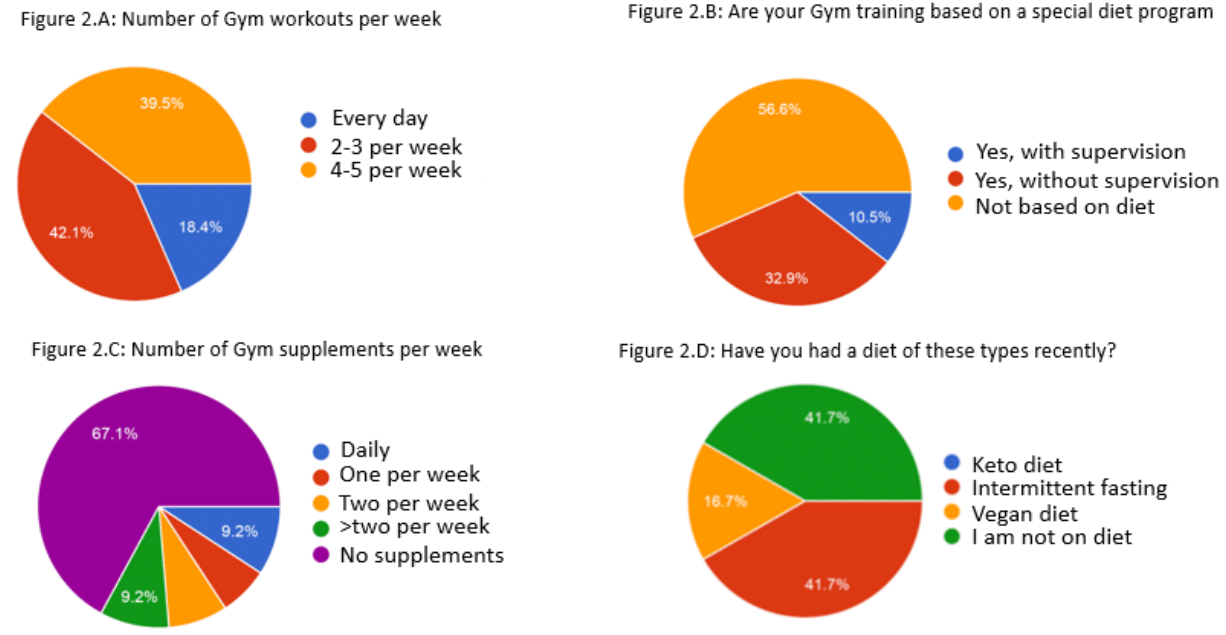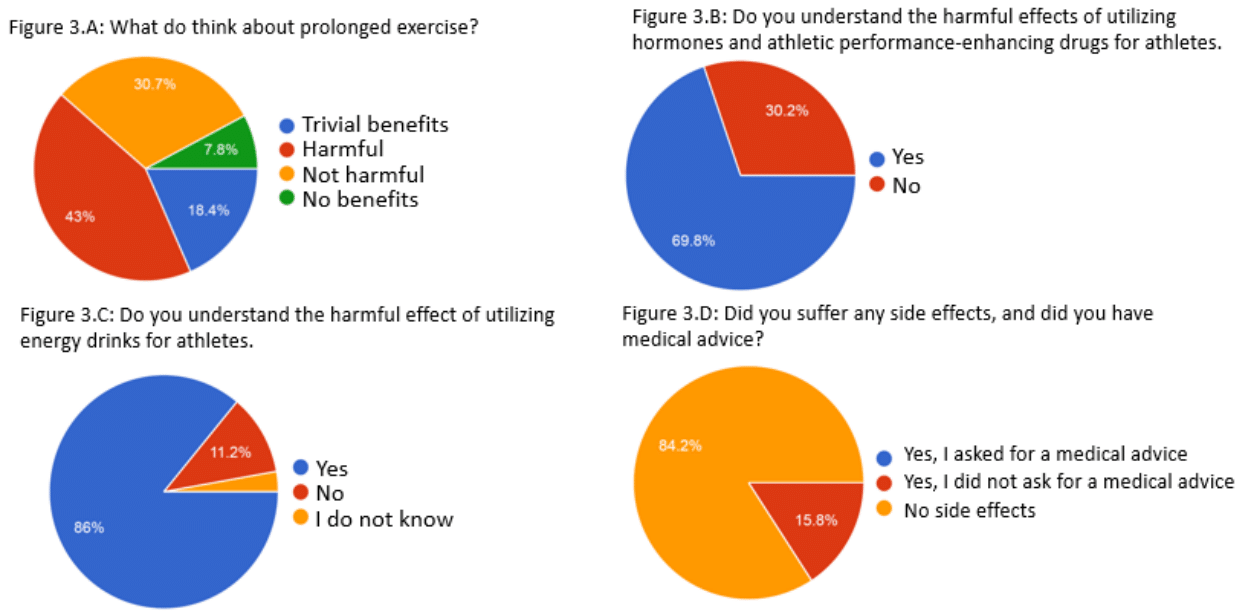eISSN: 2378-3176


Research Article Volume 12 Issue 2
1Clinical Sciences Department, MBBS Program, Fakeeh College for Medical Sciences, Jeddah 21461, Saudi Arabia
2Dr. Soliman Fakeeh hospital, Jeddah, Saudi Arabia
3Urology & Nephrology center, Mansoura University, Egypt
Correspondence: Ahmed Akl, Consultant (Associate Professor), Clinical Sciences Department, MBBS Program, Fakeeh College for Medical Sciences, Jeddah 21461, Saudi Arabia, And Consultant of Nephrology & Transplantation, Urology & Nephrology center, Mansoura University, Egypt, Tel +96 655 9321074
Received: May 01, 2024 | Published: May 16, 2024
Citation: Akl A, Alawaji R, Fatani S, et al. Awareness and knowledge of related gymnasium related kidney diseases in Saudi Arabia. Urol Nephrol Open Access J. 2024;12(2):23-26. DOI: 10.15406/unoaj.2024.12.00350
Background: A gymnasium is a place for physical activities and frequent consumption of hormonal and non-hormonal supplements by athletes in order to build muscles and gain strength in a short time. The gymnasium can be the cause of several renal diseases through different practices such as extensive exercises, consuming energy drinks, and insulin injection. In addition, the use of anabolic steroids has a direct and indirect impact on kidney health.
Aims: The aim of this study was to assess people's awareness and knowledge of certain bad athletic behaviors leading to kidney disease. Young people could play a role in changing the behavior of their society and raising awareness.
Methods: This study employed a cross-sectional survey design. Our questionnaire was used to assess levels of awareness and understanding about Gymnasium, body building, and the associated negative effects on kidney health and illness. An online questionnaire was created using Google Forms, and a link was sent. To fill out the questionnaire, each participant must first consent to participate. Following the coding of the questionnaire responses, statistical analysis was performed.
Results: The participants were mostly in the western region of Saudi Arabia. Of the 191 individuals, 93.7% preferred to use the Survey in Arabic; 41.7% were female; and their ages ranged from 15 to 41 years old, with an average of 29 years old. The young age group of 21–25 constituted 33.3%, and 25% were > 41 years old. The majority of participants were from Jeddah, Saudi Arabia (66.7%). It was clear to us that most people had less knowledge about the relationship between exercise and kidney failure (57%). On the other hand, there was a high percentage of people who believed that steroid and hormone use was harmful to their health (69.8%). In addition, we found that the majority of people who exercise are over 41 years of age, which leads to a higher level of awareness of nutritional supplements and knowledge.
Conclusion: Nephropathy in the gym is complex, and its prevention relies on public knowledge, support, and active engagement. We urge that health workers and medical students play an essential role in raising awareness and information about the risk of nutrition supplements on the kidney and those public lectures be presented regularly.
Keywords: gymnasium, kidney health, glomerulosclerosis
FSGS, focal segmental glomerulosclerosis; AAS, anabolic androgen steroids
Gymnasium is the Latin word for the old Greek word gymnasion, which refers to a location where young men engage in physical and intellectual pursuits. It is a hub of intellectual activity that can be found in European languages. In contrast, Gymnasium in English is described as a venue for purely physical exercises and is abbreviated to "Gym". Nowadays, in the gym, athletes routinely ingest non-hormonal and hormonal supplements in order to gain muscle size and strength quickly.1 Gymnasium practitioners are unaware of the risks of high protein intake and its impact on kidney health. The purpose of the following study is to analyze knowledge, practice, and perception of the negative effects of gymnasium practice and its relationship to kidney disorders.
This study used a cross-sectional survey design. Our questionnaire was used to examine people's awareness and understanding of the detrimental consequences of gym and bodybuilding supplements on kidney health and sickness. An online questionnaire was built using Google Forms, a survey was collected face-to-face, and a link was provided to university students and their families to complete. To complete the questionnaire, each participant must first agree to participate. Our study was authorized by our Ethical Committee, with the Institutional Review Board number 128/IRB/2020.
Assessment
An online questionnaire was created using Google Forms, and a link was sent. To fill out the questionnaire, each participant must first consent to participate. To collect the participants' sociodemographic information, a survey was administered with age categorized into five groups, sex coded into male and female, residential location collected in free text format, and preferred survey language coded into Arabic and English. To determine the frequency of gym training and supplement usage, four sequential questions were asked:1 The number of gym workouts per week, which might be every day, 2-3 times per week, or 4-5 times per week.2 Do you take gym supplements under specialized supervision? Yes, with supervision; no, without supervision; or do not use supplements.3 Number of Gym supplements per week: daily, one per week, two per week, more than 2 per week, or never.4 Have you had a diet of these types recently? Keto, intermittent fasting, Vegan diet, or I am not on a diet. The assessment of the understanding Of Hazards of Extended Exercise and Gymnastic Supplements was collected through 4 questions:1 What do think about prolonged exercise? Trivial benefits, harmful, not harmful, no benefits.2 Do you understand the harmful effects of utilizing hormones and athletic performance-enhancing drugs for athletes: yes, or no.3 Do you understand the harmful effect of utilizing energy drinks for athletes: yes, no.4 I do not know, did you suffer any side effects, and did you have medical advice? Yes, and I asked for medical advice, Yes but I did not ask for medical advice or No side effects.
Statistics
Following the coding of questionnaire responses, statistical analysis was carried out. The data was analyzed using SPSS Inc.'s version 16.0 for Windows. To investigate the study participants' sociodemographic and clinical features, descriptive statistical analysis was performed. Statistically significant correlations between variables were investigated using chi-square tests the statistical significance was set at p < 0.05.
The participants were largely from Saudi Arabia's western region: 191 people, 93.7% of whom preferred to complete the survey in Arabic, 41.7% of whom were females, and their ages ranged from 15 to 41 years old, with an average of 29 years. 33.3% were between the ages of 21 and 25, while 25% were older than 41 years constituting the second major group of persons who exercise resulting in a greater level of awareness towards nutritional supplements. The majority of the participants (66.7%) came from Jeddah, Saudi Arabia Figure 1. 42.1% do Gym training 2-3 times per week, 32.9% are on Gym supplements without supervision, 41.7% are on intermittent fasting, and 9.2% were taking supplements more than twice weekly Figure 2. It was evident to us that most people (57%) knew nothing about the link between exercise and kidney failure. 43 % think that prolonged exercise is harmful to kidneys, 30.2% were not convinced that utilizing hormones and athletic performance-enhancing drugs harmful to athletes, On the other hand, a large proportion of people 69.8% believe that steroid and hormone use is damaging to their health. 86% were convinced that energy drinks are harmful to athletes, and 15.8% suffered side effects but did not seek medical advice Figure 3.

Figure 1 Participants' Demographic characteristics. 1.A: The preferred survey interface language by participants. The majority of participants preferred to use their native Arabic Language (93.7%) 1.B: Participants sex. Majority of participants were males (58.3%). 1.C: Participants age. Majority were between 21-25 years old. 1.D: Participants residents location. The majority were from Saudi Arabia (Jeddah, Makkah, Madina, and Yanbou’A cities) and 8.3% from Egypt (Alexandria city).

Figure 2 Frequency of Gym training and supplements consumption. 2.A: Number of Gym training per week. 2.B: Is your Gym training based on a special diet program? 2.C: Number of Gym supplements per week. 2.D: Have you had a diet of these types recently?

Figure 3 Understanding of Hazards of extended exercise and gymnastic supplements. 3.A: What do think about prolonged exercise? 3.B: Do you understand the harmful effects of utilizing hormones and athletic performance-enhancing drugs for athletes? 3.C: Do you understand the harmful effects of utilizing energy drinks for athletes? 3.D: Did you suffer any side effects, and did you have medical advice?
Training at the Gym, is a training for Life leading to creating better version of social and healthy self as described by Dogan C. 2015.2 However, practicing at the gym is not as secure as it appears and involves numerous risks. The gym main non-hormonal supplements include proteins, creatine, and vitamins, whereas the hormonal supplements are anabolic steroids.3 It was reported in the literature that 10 bodybuilders developed chronic kidney disease owing to focal segmental glomerulosclerosis (FSGS) after eating considerable amounts of anabolic steroids with a daily protein intake of 300-550 g.4 In our cohort, thirty percent were not convinced that utilizing hormones harmful to kidney health and thirty two taking supplements without supervision. High protein intake is a cause for worry because it raises glomerular filtration rates and has been linked to glomerular hyperfiltration, which eventually leads to FSGS.3 Furthermore, pure creatine powder is advertised as a muscle-building supplement. It is a safe and efficient way to increase exercise tolerance and muscle strength.5,6 Creatine is commonly used by both amateur and professional athletes.7 The observed adverse events are typically due to exercise-induced rhabdomyolysis and dehydration, which result in acute renal injury.8 Fifty seven of our cohort has no knowledge about the harmful link between prolonged exercise and kidney health. However, several cases suggest that creatine-induced acute renal damage is not linked to rhabdomyolysis.9,10 Another report described acute intestinal nephritis in two bodybuilders.11,12 Sports dieticians may recommend higher doses of vitamin D than the recommended daily amount to strengthen bone formation.13,14 A daily intake of more than 50,000 IU can produce hypercalcemia, with the possibility of metastatic renal calcification.13 Vitamin D toxicity is most commonly seen in hospitalized infants as a result of an overdose, but it is considered minimal and rarely seen in adults in normal situations.14,15 The majority (56.6%) of our survey cohort has unsupervised eit regimen. Many of protein supplements are contaminated with anabolic androgen steroids (AAS) which were found to be directly harmful to podocytes by stimulating their androgen receptors, resulting in podocyte loss and segmental sclerosis.16 AAS adverse effects include an increased risk of cardiovascular attack, acute myocardial infarction, cholestatic jaundice, transaminitis, rhabdomyolysis, and severe mood and mental problems.17
Nephropathy in the gym is complex and emerging as a leading cause of renal injury in young age, and its prevention relies on public knowledge, support, and active engagement. We urge that health workers and medical students play an essential role in raising awareness and information about the risk of nutrition supplements on the kidney and those public lectures be presented regularly.
None.
The authors declares that there are no conflicts of interest.

©2024 Akl, et al. This is an open access article distributed under the terms of the, which permits unrestricted use, distribution, and build upon your work non-commercially.